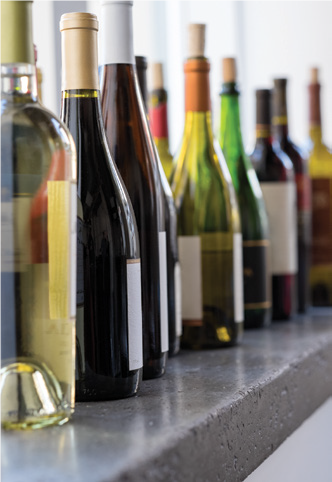
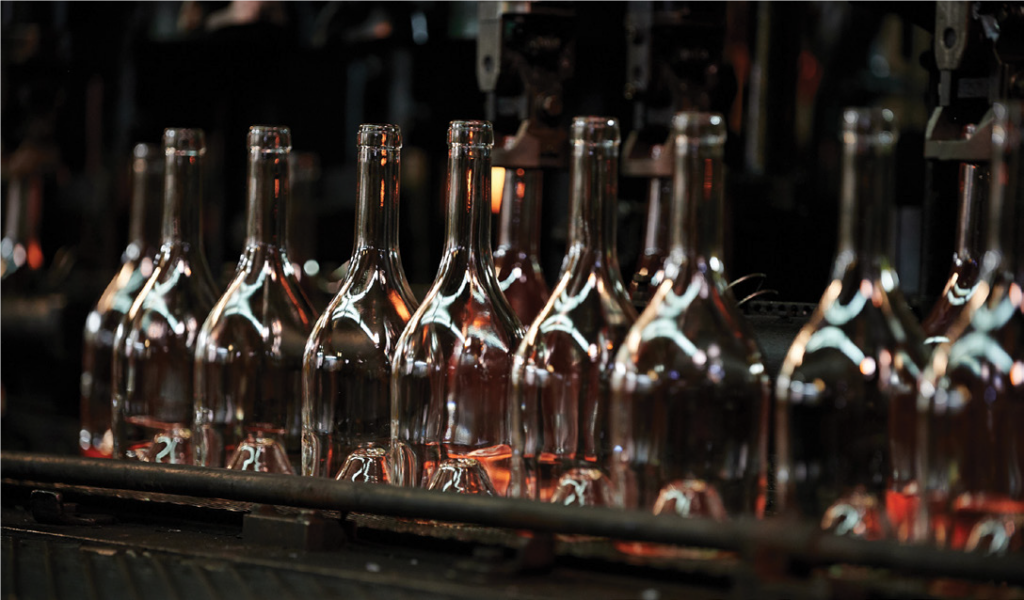
Production at Saverglass. Saverglass has teamed up with glass company Verescence to launch Vercane, a research and development project looking at low-carbon energy sources for furnaces, including biomethane and electric fusion.
THE SHRINKING FOOTPRINT OF GLASS WINE BOTTLES
By Betsy Andrews
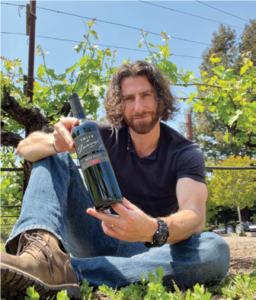
Vintner Ian Devereux White
Before he cofounded Napa Valley’s lauded Smith Devereux in 2012, vintner Ian Devereux White was a travel and wine writer. On trips abroad, he received a schooling in sustainability. “I kept asking Italians why their wine bottles were so light, and they’d say, ‘It’s so much better for the planet.’” When he returned to Napa, he was “shocked” at the relative heft of the bottles. Still, when his partners and he chose a vessel, they at first followed local custom of heavier molds.
That bottle lasted one vintage. “The energy and heat of the molds, shipping the glass, the larger cardboard to carry the weight, the glue—already there are massive environmental issues,” says Devereux White. “Then you fill it with wine, use more resources at your facility, ship it to customers, use more airplane fuel—and then the customer finishes it, and puts it in recycling, and it requires more energy to process, or there’s a good chance it’s not recycled and it takes up space in a landfill. Every milligram that glass gets heavier is exponentially worse for the planet. It didn’t feel good.”
Now, Devereux White bottles his 100-point wine in one of the lightest Bordeaux molds available from supplier M.A. Silva: the 550-gram Fuego, over 400 grams lighter than their initial choice. Most clientele accepted the switch. “Some said, ‘These look really small in my wine cellar.’ They liked heavy glass that feels substantial, powerful, and impressive,” says Devereux White. “But I couldn’t do it.” He’s not alone.
When it comes to packaging wine, glass is a miracle and a curse. As its manufacturers will tell you, it’s sturdy, which enables shelf life; it’s inert, so it doesn’t react with the liquid to create off tastes; it doesn’t have the health risks or pollutant problems of plastic; and it can be washed and reused multiple times. It is completely and endlessly recyclable.
But glass has downsides, admits James V. Nordmeyer, the vice president of global sustainability for the glass producer O-I: “It’s heavier, and it is energy intensive.” In a world in need of emissions reductions, therein lies the rub. As the wine industry struggles to shrink its carbon footprint, producers have discovered that more than half their greenhouse gasses (GHGs) are due to the shipping and manufacture of their glass bottles.
With governments now mandating climate goals for nations and businesses, however, suppliers and third-party entrepreneurs are working on new technologies and products to help make glass more sustainable. They’re not only lightening the vessel; they’re overhauling the furnaces, the material’s composition, and the infrastructures to create a glass bottle industry that can make it to net zero.
LIGHTWEIGHTING
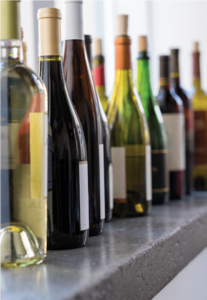
O-I wine bottles.
It’s become a term of art nowadays among eco-minded winemakers: light-weighting. Simply put, it means choosing a light lighter bottle. The issue of choice is key. The prevalence of Napa’s Cabernet-filled two pounders, with their thumb-snuggling punts and their Sasquatch-sized carbon footprints, comes from winemaker demand, says Erica Harrop, the president and CEO of Global Package LLC.
“Bottles can be made any way requested,” she explains. “As bottles became more individualized, with deeper punts and broader shoulders, the glass became heavier over the past 30 years. Now the direction is to keep the nicer shapes but get a lighter bottle. It is possible. It has been the case forever in Europe. We may forgo the 60-millimeter punt, but we can have beautiful glass.” And, notably, without concern for its durability. “They have to be careful about distribution of wall thickness in lighter glass,” says Harrop. “But it’s not necessarily stronger the thicker it is. If it’s well-tempered and -annealed then glass is really strong.”
Using technology such as the finite element method, a software-assisted microanalysis of a bottle’s geometry, and the narrow-neck-press-and-blow process, in which a plunger is pressed into the molten glass in a mold to ensure thin, uniform walls, manufacturers like Switzerland’s Vetropack Group can offer wine bottles as light as 350 grams, or roughly 12 ounces.
That’s good news for wineries like Spottswoode. A member of the International Wineries for Climate Action (IWCA), the venerable Napa Cabernet house is required to measure and lower its carbon emissions annually. Using a GHG calculator, Spottswoode’s winemaker Molly Sheppard found that product transport and packaging amounted to 50.4 percent of the winery’s emissions. Her conclusion? “Our bottles are too heavy. We don’t need quality wine in heavy bottles anymore. That’s an outdated idea,” says Sheppard.
Starting with the 2020 vintage, which will be released in 2023, the Spottswoode Estate Cabernet Sauvignon will lose its 798-gram vessel for one weighing 550 grams. Though that’s still more than the global average of 500 grams, it’s a departure from the norm among U.S. premium wines. It will make a small dent in the climate- friendly winery’s already-low emissions, “but in the grand scope,” says Shep- pard, “the more we ask of our vendors, [the more] it pushes up the chain of larger companies to track their GHGs, too.”
For Spottswoode’s owner Beth Novak Milliken, the potential sticking point was customer perception. “We know 2020 is a great wine, but it is challenging in consumers’ minds because of the Glass Fire,” which caused smoke taint in many vineyards. “We thought, ‘Should we wait?’ And then it was like, ‘No, let’s just do it.’ This is what we believe in.”
For those who think that premium wine drinkers won’t stand for premium wine in a less-than-behemoth bottle, Milliken quotes Steve Jobs: “Some people say, ‘Give the customers what they want.’ But that’s not my approach. Our job is to figure out what they’re going to want before they do.” Many other wineries are coming to the same conclusion. Biodynamic Alto Adige producer Alois Lageder has created the 450-gram SUMMA design, which they’ve left unpatented in hopes that others in the region will adopt it.
Crimson Wine Group has been transitioning its brands to lighter- weight domestic glass in the past three years, reducing their carbon output by 300 tons annually. The switch was easy, says Fintan du Fresne, the winemaker at Crimson’s Chamisal Vineyards. “There’s that assumption there’s going to be consumer pushback,” he says. “Even at the highest level of wine price, there’s been zero pushback.”
In 2016, Jackson Family Wines lowered the glass weight by five percent on its biggest molds, resulting in a two to three percent emissions decrease and a whopping $1 million savings in glass costs. When you produce the nation’s top-selling Chardonnay—Kendall Jackson Vintner’s Reserve—and tweak the bottle without repercussions, that’s proof of concept for lightweighting.
Even sparkling producers are lightweighting their bottles. It can be tricky because of the bubbles. “A sparkling bottle holds a six-bar internal pressure. If it’s flawed, it will explode. That’s why they’re so heavy,” explains Douglas Stewart, the winemaker and owner of the Anderson Valley’s Lichen Estate. Stewart turned to Saverglass’s 835-gram Champenoise Eco-Design, a bottle that’s more than 100 grams lighter than the average for sparkling wine. “The French engineered a lighter weight that’s still strong enough to hold that pressure,” he says. “But I pay the same amount for this as I would pay for a heavier bottle.”
Champagne Telmont is going even further, conducting six months of experiments in attempts to lower its packaging weight from 835 to 800 grams. “Once this final phase is complete, we will be able to communicate whether or not we will be able to commercialize the world’s lightest Champagne bottle for our entire range,” says Champagne Telmont’s president, Ludovic du Plessis. “Fingers crossed!”
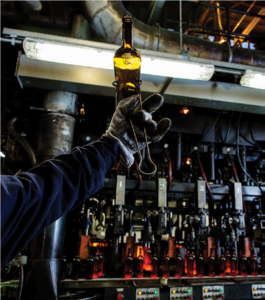
Glass inspection at Ardagh
FIXING THE FURNACE
Despite all the buzz, “We have to stop focusing on the lightening of bottles as the only solution to the emissivity of bottles,” says Regis Maillet, the marketing director at Saverglass. “Our real objective is to transform our glassmaking process. Only this approach will enable us to reach our objective of -45 percent in 2035 on our direct emissions and carbon neutrality by 2050 in order to be in line with international objectives.”
Glass furnaces are monstrous carbon emitters. Using fossil fuels, they melt glass, sand, lime, and sodium carbonate to more than 2,700 degrees Fahrenheit. Most operate continuously. “Once you turn them on, they run for 15 years,” says O-I’s Nordmeyer. Shooting for an 85 percent reduction in the carbon footprint of its containers by 2026, O-I hopes to overhaul the way it melts gas with a new furnace dubbed MAGMA, for Modular Advanced Glass Manufacturing Asset. At a third the size of a conventional furnace, it’s energy efficient, adaptable to alternative fuels, and able to turn off and on. In the meantime, the company is working on a circular system, capturing heat from its furnace in Reims, France, to supply to surrounding homes.
Similar initiatives are happening in glass manufacturing across Europe. Encirc, which has bases in the U.K. and Italy, worked with nonprofit Glass Futures to pioneer the use of biofuel in furnaces. French glassmaker Verallia is investing in electric furnaces at its factory in Cognac. German manufacturer Wiegand-Glas has developed a line called Eco2Bottle, produced using climate-neutral hydropower. And glass producer Ardagh has created Europe’s largest behind-the-meter storage system, using Tesla batteries to store and then return energy to the grid when the furnace isn’t using it.
Many of the efforts around furnace sustainability are cooperative. Saverglass has teamed up with glass company Verescence to launch Vercane, a research and development project looking at low-carbon energy sources for furnaces, including biomethane and electric fusion. The Federal Association of the German Glass Industry is researching hydrogen as a substitute for fossil fuels in glass production.
And, in the most ambitious scheme, FEVE, the European Container Glass Federation, dreamed up an electric-meets-hydrogen model called the Furnace of the Future. “Molten glass conducts electricity,” explains Fabrice Rivet, the technical director of FEVE. “You can place electrodes in molten glass so that electricity will flow through the glass and heat it up. This is a very efficient way for producing glass. Full electric melting exists already but is limited to small-scale furnaces producing only clear glass and with no, or limited, post-consumer glass.”
The Furnaces of the Future project, or F4F, has aimed to demonstrate that 80 percent electric is possible in a large-scale furnace producing glass of all kinds with high levels of recycled materials. “The industry will be able to reduce furnaces’ CO2 emissions up to 60 percent,” says Rivet. As furnaces need continual combustion to ensure proper temperatures and quality, F4F also aims to replace the remaining natural gas in the system with carbon-free hydrogen.
Yet, though 19 FEVE members were backing it, in a field of more than 300 grant applicants, the project failed to win the financial support of the EU Innovation Fund. “Without the EU grant, the project cannot be pursued as initially planned,” says Rivet. It nonetheless galvanized the industry toward “one common goal: the transition to a resource-efficient and low-carbon economy.”
RECYCLED CONTENT
“The gassing-off from the fusion of turning sand into glass is inefficient and polluting,” says Harrop. “It takes 1.2 tons of raw material to make one ton of glass, and you lose 10 percent to the air.” The solution? Instead of sand, turn glass into glass.
In other words, recycle. “But you don’t just take any bottle and throw it in there. You don’t want to contaminate the furnace. Where are we going to find good, clean recycled product?” The answer is easy in Europe, where the infrastructure supports the recycling of 80 percent of post-consumer glass. “Every ton of recycled glass saves 1.2 ton of virgin raw materials, with a three percent energy reduction and a five percent GHG emissions reduction for each 10 percent of glass recycled in the furnace,” notes Rivet.
European bottles contain, on average, 52 percent recycled content, called cullet. To increase that percentage, manufacturers launched Close the Glass Loop, a campaign to bring government authorities, glass producers, and recyclers together to achieve a 90 percent collection rate by 2030. Comité Européen de Enterprises Vins, the association representing Europe’s wine producers, is among the stakeholders.
Many European wineries are aiming for carbon reductions through recycled materials. Sacrificing their rosés’ visual impact, both Spain’s Bodegues Sumarroca and Champagne Telmont have pivoted to using only dark bottles, which can contain up to 86 percent cullet, compared to conventional clear glass, which has none.
Even better is Wild Glass. The two-year- old brand is 100-percent recycled. Uncorrected for blemishes that don’t affect functionality, Wild Glass sports a sea foam hue from its mix of cullet. It has, says Harrop, the “organic and authentic” feel of hand-blown glass, with a reduced footprint over other commercial bottles. The founder and winemaker of Napa’s Tarpon Cellars, Jeremy Carter, has adopted Wild Glass as a duty and a selling point. If a supply of the glass is available in time for bottling, they’re even planning to use it for their $150 Cabernet Sauvignon. “Being a younger winemaker with a younger brand, it’s important to lead by example.
Sustainability isn’t a feature. It’s a matter of course,” he says. “When you show other people what you’re doing, you not only encourage other brands to follow suit but also create a connection to buyers who share your values.”
Carter and other winemakers like him don’t currently have an American-made option for recycled-glass packaging. Alas, U.S. recycling rates are only 30 percent. “The hardest part here is that we have a very bad national recycling program. It’s run by counties, and there’s not enough recycled glass,” says Harrop. In states like California, which mandates 35 percent recycled content in glass production, manufacturers have difficulty procuring cullet.
To drive higher recycling rates and shore up supplies, O-I has bought recycling facilities in Colorado and Oregon and is partnering with communities through its Glass4Good initiative. With every ton of glass it collects, the company donates to the American Red Cross or United Way for projects in that community.
B2B REUSABLES
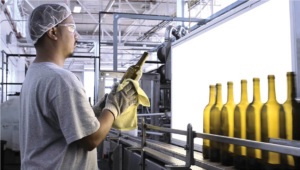
Bottle inspection at Conscious Container
One solution avoids the furnace altogether: returnable wine bottles. Outfits like The Gotham Project and Good Goods attempt to create a circular glass economy based on consumer buy-in. But wine drinkers have proven unreliable with returnables. New initiatives use a business-to-business model instead. Six percent of O-I’s global volume of glass goes into returnable systems, particularly in South America and Europe. In North America, the company is piloting returnable programs with partners in Oregon, Kentucky, and Quebec. “But you need an ecosystem,” says Nordmeyer. “You need government regulation, a producer, and an interested partner to get the B2B.”
Also, for refillable schemes to be effective, producers must agree on standard shapes and sizes. Since the look of the vessel is integral to winery branding, such standardization is difficult. Some are still trying. Caren McNamara founded Conscious Container on a mission to create a reusable bottle economy for the California wine industry. With the support of a Cal Recycling GHG reuse grant, Conscious Container is now set to sort and wash glass collected at recycling centers or left over from big producers like Jackson Family Wineries to resell to small and medium wineries.
To Nordmeyer’s point, McNamara is working on creating an ecosystem for her endeavor. She lobbied successfully for California’s AB 962, the California Beverage Container Recycling and Litter Reduction Act, a bill to facilitate reusable beverage containers, which passed in October 2021. It recognizes glass bottles as refillable and, therefore, able to be separated from the recycling stream by vendors. She’s pushing for wine bottle standardization and a law that will allow wine and spirits bottles into the state’s bottle redemption plan, to ensure consistent supplies for washing and reuse. With a new bottle washing machine coming from Europe, McNamara anticipates beginning to wash bottles in August. “We’re just getting the wheels turning,” she says.
Of course, all these efforts are for naught if winemakers can’t get their hands on enough glass at a price they can afford. “We have consciously avoided using heavier molds because we believe in trying to be as sustainable as possible,” says Brad Jonas, co-owner and winemaker of Mendocino’s Minus Tide Wines. “But as a growing, scrappy winery, we have to pay attention to our costs, and packaging is one area where we can’t spend too much.”
A true infrastructure around recycling and returnables might alleviate the financial and supply pressures for winemakers seeking sustainable alternatives. “A multifaceted approach will take collaboration in industry and policy,” says McNamara. “All I can say is that everybody wants to figure out how to do this.”



